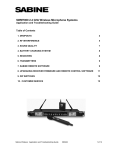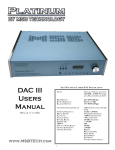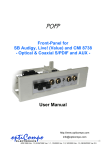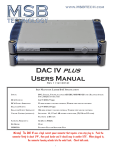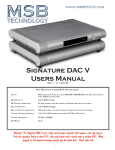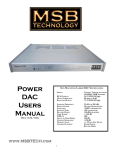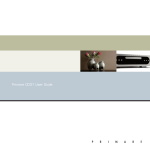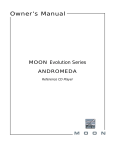Download MSB Technology Gold Link Dac III Specifications
Transcript
Users Manual Thank you for purchasing the world famous PLATINUM LINK DAC . We are sure you will be very pleased with it. At least 100 hours of burn-in is required on this DAC. Customers generally recommend one month. Setup and Quick Start The front panel is quite simple with few user controls. Set the input source to auto and start with all the other options off (No LED lit). Power The Platinum comes standard with an inboard power supply. If it is not labeled otherwise it can be assumed to be configured for 120 Volt operation. Fuses can be moved inside for conversion to 220V. Inputs The Platinum comes standard with MSB Network (CAT5), AES/EBU balanced, coaxial and optical digital audio inputs, ranked in order of performance. Connect any digital input to any active digital audio source. The frequency of the incoming signal will be read out on the front panel and analog audio will be found on both balanced and single ended analog outputs. Outputs Connect the analog outputs to any passive or active volume control and audio should be present. The output level is quite high so operation with a passive volume control is possible. If the level is too high for your preamp, an attenuation cable can be ordered from MSB. Standard Configuration - As shipped Balanced Input: AES/EBU MSB Network (192k) MSB Network Channel 1st (Front) 2nd, 3rd, 4th Data Inversion: Normal Inverted ATT Glass Input: Installed None Each option is described in detail later in the manual. PRELIMINARY SPECS: 4 SIGN MAGNITUDE 46 BIT LADDER DACS INPUTS: C OAXIAL , T OSLINK , BALANCED AES/EBU, MSB NETWORK (192K), OPTIONAL ATT GLASS OUTPUTS: L INE LEVEL 4V RMS (12VPP) BALANCED LEVEL 7.5 V RMS (20VPP) SAMPLING FREQUENCY: 1.5 MHZ DIGITAL FILTER: BURR BROWN DF1704 SLEW RATE: >1000 V/MICROSECOND SETTLING TIME: <100 NANOSECONDS DYNAMIC RANGE: 134 dBA MEASURED NOISE FLOOR: < -145 dB 2 46 Bit, 384 kHz ladder DAC with 130 dB Signal-to-Noise and Upsampling! MSB’s Platinum DAC is the expression of an entirely fresh approach to Digital-to-Analog conversion. The perspective the industry has adopted concerning DACs has been revisited… and blown away! Here is an explanation of what you have to look forward to: Unique Technology - the past and the future Over 10 years ago early DACs were all 16 bit ladder DACs, with a precision laser-trimmed resistor creating the appropriate analog level for each of the bits. The DACs worked well and sounded good. They were quite expensive as very accurate resistors were required. Then along came the “single bit” DACs. Rather than using a resistor to create an analog level, pulse width modulation was used. Basically each bit was created by turning a switch on and off for the appropriate length of time. The resulting square wave pattern is filtered to create a smooth output. The expensive resistors were gone, and so was the good performance. Next came the Delta Sigma DAC. It used the same pulse width modulation but rather than creating a single large pulse for each data point, the data point was created with many small pulses. This allows the pulses to be smoothed with a less radical filter, and improves the sound. As you can see, upsampling the input signal to a higher frequency reduces the filtering requirements and thus improves the sound. This is the current state-of-the-art as exemplified in the LINK DAC III with the upsampling option. The Platinum draws from the older, superior ladder technology, but Right Channel with incredible improvements. The Platinum contains four 46 bit MSB DAC Module (Non-inverted signal) MSB DAC modules (seen below). The Platinum is fully balanced 23 bit positive sign DAC so there is a matched pair of 46 bit DAC modules for the inverted 23 bit negative sign DAC and non-inverted signals on each of the right and left channels. Finally, each DAC module contains one R2R ladder DAC with a 23 bit MSB DAC Module (Inverted signal) Coaxial Out negative sign and one R2R ladder DAC with a 23 bit positive sign. 23 bit positive sign DAC This design allows the quieter moments in your music to be true to 23 bit negative sign DAC the music, without the linearity errors near zero that plague normal Balanced Out ladder and delta-sigma DAC designs. With 46 bits of combined BLOCK DIAGRAM resolution, a 24 bit source gives a true 24 bit resolution without the losses and errors that make your normal 16 or 24 bit DAC perform far less than their actual resolution (normal 16 bit DACs only muster a meager 12 bits of resolution). The Platinum is carefully designed so as to require no DC correction in the output stage. This allows direct DC coupling on the output stage for pure, uncolored sound -- with no output filtering to muck up your high end or smear your bass attack. And for those who require a balanced analog output, the separate positive and negative DACs directly drive the balanced outputs, with no analog output stage at all! Another major difference in the Platinum is the type of output. Essentially all ladder DACs produce a current output. This is converted to a voltage output with a current to voltage converter. This problematic circuit colors the sound and introduces nonlinearity. The Platinum is a true voltage DAC with a voltage output right from the source. All amplifiers have slew rates greater than 1000 Volts/microsecond. The output impedance of the Platinum is 75 ohms. A special directional cable with 75 ohm termination is available. This allows a matched impedance load independent of the impedance of the volume control. Front Panel Features The MSB Platinum has 6 control buttons on the front panel and a frequency display. The buttons toggle on and off. When on, the LED next to the button is lit. 3 Upsampling, Interpolation and filtering The MSB Platinum grants the user the ability to upsample from ANY lower audio standard to 24bit/130.2kHz (just under 3 times the CD rate). This is a selectable feature and may be turned off. To play a 24/192 disc the Platinum only needs an input option installed to be fully compatible. This upsampling feature also dynamically buffers and re-clocks all the data and clock signals to provide a virtually jitter-free source directly to the DACs. Interpolation is also selectable, with 16X or 8X being possible. The selectable digital filter response permits the user to choose the filter design they prefer. It allows for the selection of a standard brick-wall filter or a slow roll-off filter, both at half the sampling frequency. Each provides the listener with a distinct, glorious listening experience. You may favor one or the other, or enjoy changing the filter response to suit the music you listen to. Music with less high frequencies may benefit from the slow roll-off filter. INTERPOLATION ON UPSAMPLING ON Front Panel Controls Frequency Display – The actual sampling frequency of the incoming signal is INTERPOLATION displayed. This is not the normal display of the frequency reported by the AND decoder, which, for example, would always read 44.1 kHz even if the trans- UPSAMPLING port was playing at 44.3 kHz. The MSB frequency counter displays actual ON frequency so don’t be surprised if some lower cost DVD transports fail to produce an accurate playback speed. Upsample On – The incoming data is resampled at 130.2 kHz. This is three SIGN WAVE (0DB, 19.95 KHZ TEST TONE times the CD rate. This is a true upsampling, not a parallel scheme as some SCOPE SETTINGS 2 V/DIV, 10USEC/DIV) DACs do. The feature can be turned on or off, but the jitter reduction inherent in this process remains on in either case. Option – This button toggles between the 4 sets of input channels of the MSB Network in the future but is not currently activated. Input Select – Each of the five inputs can be selected manually, or the auto mode can be selected. The auto mode is an automatic priority switching with auto signal detection. In either case, active sources light up the input LED at half brightness, and the selected source at full brightness. The CAT5 MSB Network input always takes priority regardless of input settings. 16X Interpolation - Interpolation is like oversampling. You may select either 8X or 16X. This option works with upsampling on or off. Interpolation is a function of the digital filter. It is the number of data points created between each actual data sample. There are no simple explanations, but in general terms, the higher the sampling frequency, the more artifacts, such as the image frequency, are pushed up beyond the audio range. With this effect comes some detrimental artifacts as well. The trade-off in performance depends on your system, hearing and taste in music. As a rule-of-thumb, 16X is more appropriate for low sampling rate sources and 8X would be better for 96K or 192K sources. Filter On - This feature adjusts the slope of the digital filter. This feature is very much related to the interpolation feature above. The Platinum defaults to the gentle filter slope. In this case some of the image frequencies can be reflected into the audible range, but the negative energy spread effect of filters is minimized. This setting is best for higher sampling rate sources such as 96K or 192K. For low sampling rate sources the brick-wall filter may be desirable as image frequencies are more likely to affect the sound. Again, these rules-of-thumb can be dramatically affected by your personal taste. Phase Invert - This feature allows improperly recorded material to be corrected. The phase of the outputs is inverted digitally. 4 Rear Panel Details Digital Inputs Toslink – Although this format has the lowest bandwidth, it is one of the more common outputs on low-end products. It also offers ground isolation between products and noise immunity over long runs. Coaxial – A good input for short runs and lower frequencies. ATT Glass – This ST type optical input is robust and high speed, but less commonly used. This input is offered as a customer installable option. Balanced – The AES/EBU Professional input is the preferred input. The balanced nature of this input allows great cable lengths as well as total noise immunity. It is used for both digital audio and the MSB Network. The Platinum is configured connector next to the AC power connector is an auxiliary output, not an input. MSB will supply a DIN to DIN cable upon request. Dual MSB Network – These dual CAT-5 connectors are actually a bridged input and provide a second MSB Network input or output. Multiple DACs can be daisy chained together using one connector as an input and the other as an output. The MSB Network One of the most powerful new features of the Platinum is that it is the first product to incorporate the new MSB network. This network plugs into the balanced input of the Platinum and is automatically detected and activated. The MSB network has the following capability: * Unidirectional communications over any twisted pair * Simultaneous transmission of 8 audio channels with 34 bit resolution at 192 kHz sampling rate * Simultaneous transmission of 8 data channels with 3 Mbs data rate (for volume and trim data) * A single serial channel of 384 kbits/sec for control and system data. This network is our answer to 192 kHz audio transmission and multichannel transmission in the same package. We provide network outputs to our own transport and offer a source upgrade to your transport as well. In our next generation surround processor upgrade, up to 8 channels of decoded data can be sent through one wire. The twisted pair format is very convenient as it has become the standard for all computer netMSB NETWORK CAPABILITY TWISTED PAIR WIRING works. Ethernet networks use CAT5 wire which contains 4 twisted pairs. XLR CONNECTORS (AES/EBU COMPATIBLE) This one cable could be used to send 32 channels of 34 bit, 192 kHz audio EIGHT 34 BIT 192 KHZ AUDIO CHANNELS data! Several cables are available for connecting MSB transports to the 8 CONTROL CHANNELS Platinum including CAT5 cable at any length up to 80 feet and CAT5 to XLR EXTRA SERIAL CHANNEL cables. Analog Outputs Balanced – The balanced audio outputs are the preferred output format for those customers with a balanced system. As the PLATINUM is fully balanced, both the inverted and non-inverted outputs are generated directly by separate DACs and sent to the balanced outputs without filtering, buffering or any analog circuits that could color the music. The balanced outputs provide a 20 Vpp at 0 dB (7.5 V RMS). Coaxial – We combine the inverted and non-inverted DAC outputs in a high-speed summing amplifier. The output impedance is 75 ohms and output level is 12 Volts PP (4 V RMS). This rather hot output can be attenuated using a special cable included that reduces the output to standard line level. Use this cable when a high gain preamp is part of the system. Use standard cables when a low gain or passive volume control is used. 5 Power Supplies Each function within the Platinum is provided with its own separate power supply. There are 5 power supplies in the digital portion and 6 in the analog. The power supplies in the digital section ensure the maximum jitter reduction while the 3 power supplies for each of the left and right DACs allow for the greatest channel separation possible. The analog power supplies are the original high-speed discrete supplies used in MSB audio products for over 13 years. The Platinum includes a built-in P1000 Power Base, with its high performance triple wound toroidal transformer and rectification. It can be configured internally for 120V or 240V and has a detachable cord. Also provided is extra DC output that can be used to power another MSB product like a volume control. The DIN connector next to the AC power connector is an auxiliary output, not an input. MSB will supply a DIN to DIN cable upon request. Voltage Conversion and Changing Fuses Remove the cover of the Platinum. Work on a soft scratch resistant surface like a carpeted floor. Three screws are located along the back edge and three screws on the bottom along the front edge. With these screws out, the cover lifts off. Now the power supply must be separated from the DAC. Each side panel is attached to both the top DAC part and the lower Power supply part. Remove the screws from the lower Power supply part. There are also screws between the two parts along the back edge. On newer units, the circuit board has two notches along the back edge. These notches line up with the threaded holes from the cover. Remove the screws that can be found in each notch. Older Platinums may not have notches. In that case the main circuit board must be removed to gain access to these screws. Now separate the power supply part from the DAC part. The Platinum can be configured for 120V or 240V operation by changing the location of two fuses internally. For 100 to 120 Volt countries, fuses are placed in F2 and F3. For 230V to 240V countries, the fuses are removed from F2 and F3 and one fuse in inserted in F4. All units can be assumed to be set up for 120V operation unless a 240V gold sticker is attached to the back of the unit. Replace fuses with 3A 5mm x 20mm miniature fuses. Fuses may blow during unusual power surges or disturbances. Protect this product with a good surge protection power supply as changing fuses is quite a big operation. MSB Network Input and Channel Selection INPUT DECODER MODULE DIGITAL FILTER MODULE DAC MODULES The MSB Network supports 4 stereo channels of 192k data at once. Any DAC can be configured to decode any of these 4 channels. For example, when an upgraded DVD player is playing a DTS music CD, one DAC can be configured to Channel 1 and will receive the front channels. A second DAC can be attached to the same wire at the same time and by selecting Channel 2 will receive and decode the rear channels. The 3rd chanNormal Balanced input Move both down for MSB Network input Channel 2 selected (Rears) Channel 1 selected (Fronts) nel is for the front and sub channels if you want to use them. The 4th channel is for future formats which may come along. Move the jumper located on the input board as shown in the diagram to select the channel. More than one DAC can be attached to the same cable by taking advantage of a DAC with both an input and output like the Platinum to 6 create a daisy chain configuration. An MSB Network output upgrade provides three identical connectors allowing three DACs to be driven at once, each set up for a different channel. The other jumpers on the input board are to change the balanced input to an MSB Network input. Note the two jumpers are moved toward the center of the board. In this mode, when the balanced input is selected, the presence of an MSB Network signal will cause the Network LED to light and the Network signal to be decoded. This change defeats the CAT5 input. This option should only be considered when front panel switching of two active sources must be accomplished. The CAT5 is a superior input connection and should be used if possible. Troubleshooting No “Source” indicated on LEDs - Check for bad cable, or cable plugged into the wrong output on the transport. No sound - Check that source is valid audio source. Change to a standard CD just to be sure. Check that analog outputs are connected properly. Still no sound - connect an analog output from the source directly to the volume control. Verify that the rest of the system is working. Now move the same analog cable to the DAC and plug in a digital source. You should hear a click and the front display should indicate frequency. You hear audio clipping - the output level may be too high for your preamp. Check the input specifications on your preamp. (See Platinum specs). MSB offers an attenuation cable which drops the Platinum levels to the standard 2 V RMS industry specification. The unit does not work powered on 240V - unplug power quickly or capacitors may smoke. The unit is configured for 120V unless clearly labeled. If you suspect you may have a 240V unit, it will work at 120V. Call MSB for a procedure to verify the voltage configuration. Frequency readout is off - The Platinum upsamples to a little less than 3 times a 44.1K source rate. Upsampling always converts any input to 130.2. We have selected this frequency as an optimum rate that will accommodate all sources. This is normal. The MSB Network input may output two frequencies, depending on the source material. With 44.1 and 88.2 sources the frequency reads 176.4k which is four times the sampling rate. With all other sources, the frequency will read 192k. 96K source indicates 48k on front panel - Check setup menu of DVD player. Digital output should be set for 96k output. Some models do not support this feature and downmix to 48k. DVD-A source indicates 48k - DVD-A players must be upgraded to provide a true 192K output. Production players downmix to 48K. Warranty All MSB products carry a one year warranty. No returns accepted without an RMA. Upon receipt, MSB will repair or replace any defective product. All product shipped FOB La Honda. Shipping and shipping damage is the responsibility of the consignee. 7







